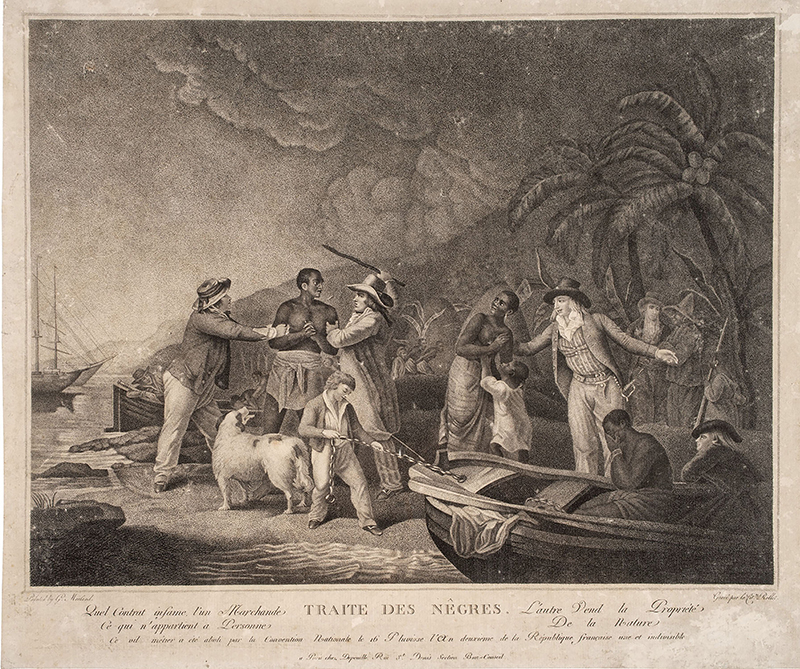The Captured Runaway, 1856, by William Gale, British, 1823–1909. Bowdoin College Museum of Art, Museum Purchase, Jane H. and Charles E. Parker Jr. Art Acquisition Fund, 2021.48.
On January 25, 2024, the Bowdoin College Museum of Art will open “The Book of Two Hemispheres:” Uncle Tom’s Cabin in the United States and Europe. This exhibition explores the international circulation of imagery that propelled the widespread if controversial fame of Uncle Tom’s Cabin and its author Harriet Beecher Stowe in the decades following its publication in 1852. Stowe’s ardent condemnation of slavery shook an already divided American society and quickly caused a sensation across Europe. Penned here in Brunswick, Maine, The book grappled with several issues of international concern during this period that also resonate powerfully today, including labor exploitation, gender violence, nationalism, colonization, religion, and the very nature of liberty and humanity. In nations like Britain and France, which had previously abolished slavery throughout their colonial empires, the book’s complex themes elicited a mix of responses from excitement to moral outrage and even racist parody. Just months after its appearance in Britain, for instance, one of the country’s leading news outlets The Illustrated London News noted the sweeping impact of Uncle Tom’s Cabin and called it “the book of two hemispheres.”
The Book of Two Hemispheres features examples of painting, sculpture, print, and photography from the BCMA’s collection, along with significant loans from the George J. Mitchell Department of Special Collections & Archives at the Bowdoin College Library and the Harriet Beecher Stowe Center in Hartford, Connecticut. A blend of examples from fine art and visual culture reveals the far-reaching impact of Uncle Tom’s Cabin and the many different ways that its narrative and themes were adapted and reimagined by translators, publishers, illustrators, artists, playwrights, and composers across diverse national and cultural contexts. The book gave rise to many translations and editions, and its most memorable characters and scenes appeared in numerous media. Weak copyright laws meant that Stowe had little control—especially internationally—over changes made to her work. As the story was reinterpreted across decades and continents, it became increasingly detached from its original message, sometimes in explicitly racist ways. Paradoxically, while the book took on a life of its own, Stowe herself became frozen in time as “the author of Uncle Tom’s Cabin,” her prolific writing career often condensed down to this one literary achievement.

Bowdoin College faculty and students were crucial to the exhibition’s conception and development. As the campus community is one of the primary audiences for this exhibition, it was important to seek their guidance and recommendations. Contributions ranged from insightful questions and ideas to practical suggestions for the exhibition’s layout and graphic presence. BCMA staff held group discussions with Bowdoin faculty members from Art History, History, Africana Studies, and English, and with Library staff, and students from a variety of disciplines to discuss strategies to engage with racialized and sometimes overtly racist imagery and language. What came out of those group discussions was the importance of decentering Stowe while still critically analyzing her fraught relationship with the continually morphing history of Uncle Tom’s Cabin and her own public image. There was great sensitivity to the differences in how the book was interpreted by audiences from different cultural backgrounds at different times.
The works on view demonstrate how a story with an antislavery message could nevertheless lend itself to racist interpretations as ideas about enslavement and racial difference were contested and reframed on both sides of the Atlantic. In considering both the novel’s and Stowe’s complicated legacies, viewers may find themselves contemplating equally complicated questions: Did Uncle Tom’s Cabin move society toward justice and liberation, or is it merely a “catalogue of violence,” as Baldwin famously denounced it? How can texts, images, and institutions oppose forms of domination and oppression on the one hand, and still buy into the ideological frameworks that make those forms possible? Although the material featured in the exhibition concludes in 1900, Uncle Tom’s Cabin has never ceased to prompt debate. Its early international reception demonstrates why it still demands our attention today.
Sean Kramer
Andrew W. Mellon Postdoctoral Curatorial Fellow
Bowdoin College Museum of Art
Illlustrations:
The Slave Trade (Traite des Nêgres), ca. 1794–1795, by La Citoyenne Rollet, French. Bowdoin College Museum of Art, The Philip Conway Beam Endowment Fund, 2021.6.
Antislavery Medallion, design introduced in 1787, Josiah Wedgwood, British, 1730–1795. Bowdoin College Museum of Art, Museum Purchase, Laura T. and John H. Halford, Jr. Art Acquisition Fund, 2015.22.